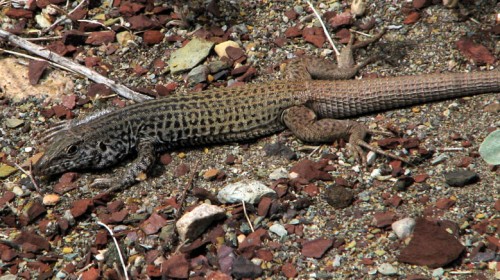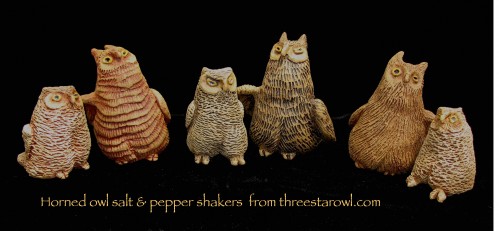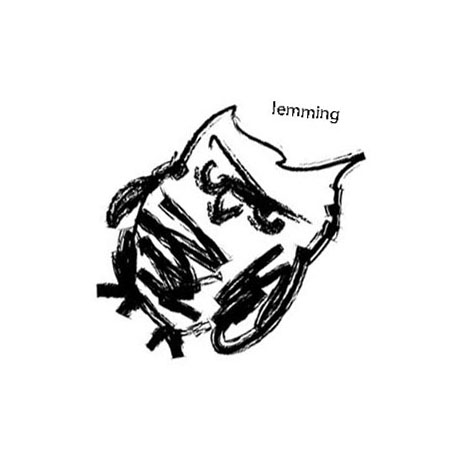Yard list: Desert Iguana, spotted
The first day of autumn has been a red letter day in our yard. Not only was there a Western screech owl calling last night — a new species for the yard, as far as my observations go — but this afternoon, in the heat of the day, a young Desert iguana raced under a creosote bush in the front yard, when I went out to get the mail.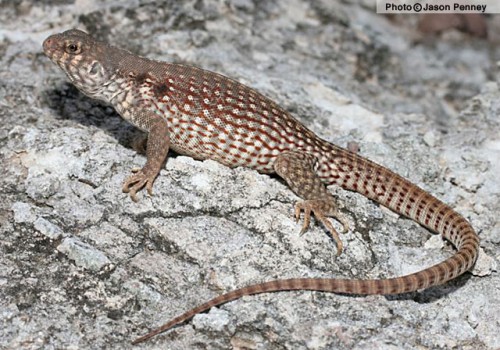
I whipped out my tiny Canon Elph but the little ‘zard was all warmed up from hanging out in the midday sun, and it sped away before hiding in the shade under the creosote where I could see him but couldn’t get a picture. So I pinched this nice photo by Jason Penney from the excellent Reptiles of Arizona website which you can check out for more detailed info about this lizard. When full grown, Desert iguanas (Dipsosaurus dorsalis) are large lizards — almost 6″not counting tail and up to 16″with it — with a blunt face, long tail, and distinctive buffy coloration below a colorful pattern of speckles. This little guy shone pale gold as it raced across the cement driveway; its color gave away its identity even before I got close enough to see him well. Tiger whiptails (Aspidoscelis tigris) the lizards we see most often around here, are darker and lower to the ground.
The little iguana was also exhibiting another trait of its kind: it was out in the hot part of the day, when most other lizards have retired to shaded shelter or underground to rest and digest their forage. Diet is another thing that makes Desert iguanas distinct from our other lizards — they’re largely herbivorous when mature, eating a variety of desert vegetation, including the yellow flowers of creosote bushes, which they will climb to feast on. The first Desert iguana I ever saw was among the spring wildflowers at the Desert Botanical Garden, grazing in the hot sun like a small-scale reptilian cow, even leaving behind it large (for a lizard) fibrous pellets of poop like plant-eaters do. And, yes, they are related to their better known cousins, the Green “Tastes Like Chicken” Iguanas (Iguana iguana) of Mexico and Central America. I don’t know what something that feeds on pungent creosote blooms would taste like.
But this is why seeing him was especially exciting: there are only a few in the neighborhood, and that number appears to be shrinking, at least by informal observation. It’s only a theory, but mortality of Desert iguanas (specifically in our neighborhood) seemed to accelerate after the City re-coated our streets with a dark sealant. It makes for good basking, perhaps, the dark surface heating up earlier and staying warm later than the old gray road, and sadly, for several weeks, I would see Desert iguana roadkill regularly: three along one stretch of a heavily-used street nearby alone. So, seeing this little guy who was perhaps this year’s hatch, or more likely a yearling, was a very welcome sight.
Etymological notes:
Dipsosaurus is constructed of Greek elements, meaning “thirsty lizard”; dorsalis refers to the spine, which in Desert iguanas is protected by prominent, keeled scales.
Aspidoscelis tigris: Aspidoscelis is also from Greek elements, and means “shield leg” because of the sturdy scales on the whiptail’s legs, and “tigris” because it is stripy.
Autumnal Owlinox — new season, new yard bird
Last night was a busy night in the yard. Well, I suppose they’re all busy nights, but last night I was awake to appreciate it. Before human bedtime, the geckos were at their posts under the porch lights (our yard residents are the non-native Mediterranean Geckos, not the indigenous Western Banded, but they’re still charmingly rubbery voracious devourers of insects, especially moths), and the Butte was going off sporadically, the coyote pack’s yelps ricocheting off the slickrock. There might have been the sharp yip of a Gray Fox, which also inhabit the neighborhood, but it was faint. Somewhere, the spadefootlets must have been hopping around foraging in the dark, as well.
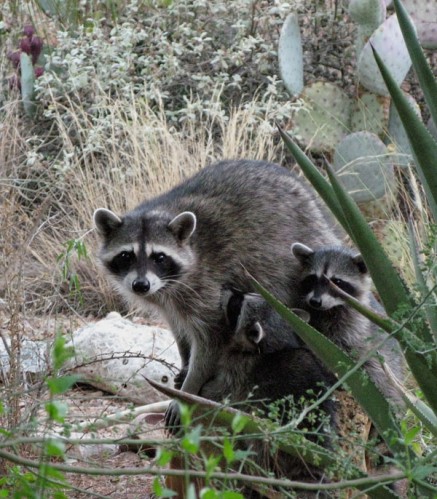 After “bedtime” though, things really got going. A female raccoon marauded past the bedroom trailed by at least one kit from this year. Last year there were two separate families, one with two, the other with three kits each. That’s a lot of pounds of raccoons living off the yard, plus Papa, too, who has only half of a tail, diminishing his raccoon-gestalt but not his swagger. We’re not sure how many there are this year, because our view of them is most often through the arcadia door, and sightings are limited to who rolls by the framed glass, like watching a dog show on the TV animal channel.
After “bedtime” though, things really got going. A female raccoon marauded past the bedroom trailed by at least one kit from this year. Last year there were two separate families, one with two, the other with three kits each. That’s a lot of pounds of raccoons living off the yard, plus Papa, too, who has only half of a tail, diminishing his raccoon-gestalt but not his swagger. We’re not sure how many there are this year, because our view of them is most often through the arcadia door, and sightings are limited to who rolls by the framed glass, like watching a dog show on the TV animal channel.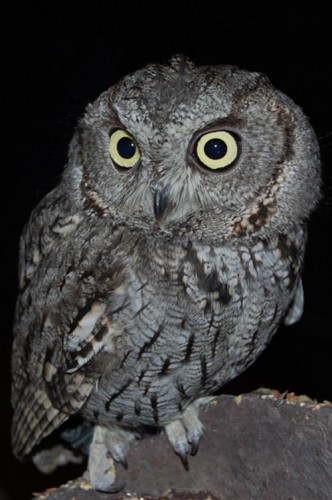
Last night the main event (for me), however, was again being awakened by an owl. Not the Great Horned owl this time, but an owl I’d never heard in our yard: a Western screech owl. They’re not uncommon in the area — I’ve seen them peering out from day-roosts in saguaro cavities at the nearby Desert Botanical Garden — but we’ve never heard or seen them in our little scrap of modified desert. This one called from just after 2 am until the Butte really exploded about half an hour later, when the owl stopped. Its mellow short hoots were emitted in a cluster which descended slightly at the end. It sounded much like the “Morse code call” of its cousin the Whiskered screech owl, but that species doesn’t live in this part of Arizona. The call was soft but regular, and started up again at 4 am, and went on for at least 45 minutes, when I fell back to sleep.
So far, like the generously rainy Monsoon of 2008, this has been a generously owly season in the yard, and this Western screech owl, who may always have been here, or who may be a new neighbor, ushered in fall last night; I’m glad I was awake to hear it. With luck maybe we’ll catch a glimpse of it sometime, hunting pocket mice and crickets under the desert trees. Right now, though, I think I need a nap: the first nap of Autumn!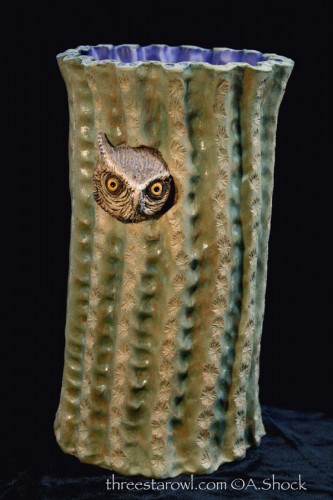
“The northern autumnal equinox takes place today, Monday, Sept. 22nd, at 15:44 UT (11:44 a.m. EDT) when the sun crosses the celestial equator heading south for the year. Autumn begins in the northern hemisphere, and spring in the southern hemisphere. Happy equinox!” (Spaceweather.com)
***
Photos: Raccoon family, A.Shock. Western screech owl by L.Kovash. Left: a Western screech owl peering from a saguaro vessel (stoneware, 12″), from Three Star Owl. Photo by A.Shock.Yard list: Great horned owls part two
Update to an earlier post:
Our local Great horned owl has a friend. Last night from about 4 am we listened to two owls duetting and singing antiphonally for about half an hour, the higher hoots of the female alternating with the lower calls of the male. It’s early in the year for coursthip, but my guess is that these are our usual, established owls reinforcing their pair bond.
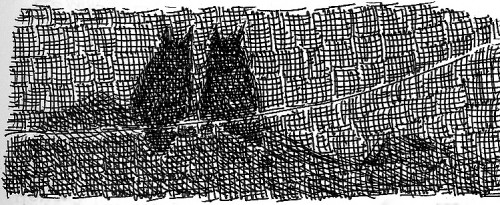
Yard List — Great Horned Owl
Last night at 3.00am exactly, I heard the Great horned owl call. Very close, somewhere right in the back yard. The windows were open because a light monsoon event had brought fresh rain-cooled air, so the call, though soft, carried clearly.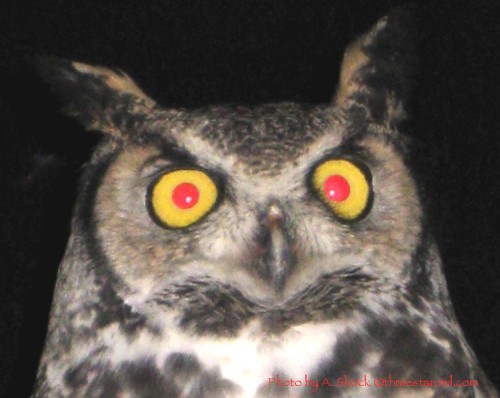
Great horned owls are regulars in our area because there are plenty of perches, and plenty for them to eat. A favorite owly destination is a big Aleppo pine in our back yard. At night that tree is stuffed with roosting doves and other perching birds, a veritable Fresh and Easy for owls. Sitting outside at dark with friends, we’ve watched a horned owl glide stealthily into mid-level branches and then listened as panic ensued among the roosting doves as the owl hopped between branches as if it were going aisle to aisle in a grocery store, filling a cart. Finally it burst out of the needles with a meal clutched in its talons. We got a good look at it is it slid past us, sihouetted against the lights of the house. The feather pool under the pine the next morning was evidence that it had enjoyed a bit of mourning dove.
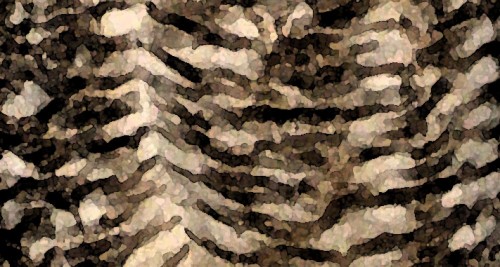 They are not called “Flying tigers” for nothing. Horned owls, like toadlets, will eat anything that moves and fits down the gullet. Rock squirrels, snakes, desert cottontails, other birds (even other owls), insects, and bats — all are fair game. Even small pets may be at risk, if left unsupervised after dark. The first owl I ever saw was at the family dinner table when I was a kid: a thump, a commotion, and we looked up to see the underside of a Great horned owl pressed to the window, wings flapping against the glass. The owl was trying to separate the family cat (a calico named Ringo, to give you an idea how long ago this was) from the window ledge. A grown cat is awfully heavy prey, however, and the owl had to give up after a few seconds. No one was hurt, but the bird went away hungry. (It was a spectacular view of an owl in action, and I’ve wondered if that was THE bird for me, in a formative sense — I was no more than seven). The boldest hunters are often adults with young to feed — a nest full of hungry owlets requires a lot of sustenance. During that time of the year, parent owls sometimes can be seen hunting even during daylight, working a day job to put food on the table. So, hatching and fledging are timed to coincide with the local peak of yearly rodent production, usually spring, but in the desert areas often much earlier.
They are not called “Flying tigers” for nothing. Horned owls, like toadlets, will eat anything that moves and fits down the gullet. Rock squirrels, snakes, desert cottontails, other birds (even other owls), insects, and bats — all are fair game. Even small pets may be at risk, if left unsupervised after dark. The first owl I ever saw was at the family dinner table when I was a kid: a thump, a commotion, and we looked up to see the underside of a Great horned owl pressed to the window, wings flapping against the glass. The owl was trying to separate the family cat (a calico named Ringo, to give you an idea how long ago this was) from the window ledge. A grown cat is awfully heavy prey, however, and the owl had to give up after a few seconds. No one was hurt, but the bird went away hungry. (It was a spectacular view of an owl in action, and I’ve wondered if that was THE bird for me, in a formative sense — I was no more than seven). The boldest hunters are often adults with young to feed — a nest full of hungry owlets requires a lot of sustenance. During that time of the year, parent owls sometimes can be seen hunting even during daylight, working a day job to put food on the table. So, hatching and fledging are timed to coincide with the local peak of yearly rodent production, usually spring, but in the desert areas often much earlier.
Our local owls have reproduced, and sometimes I’ve heard the distinctive, raspy oink of a horned owlet begging,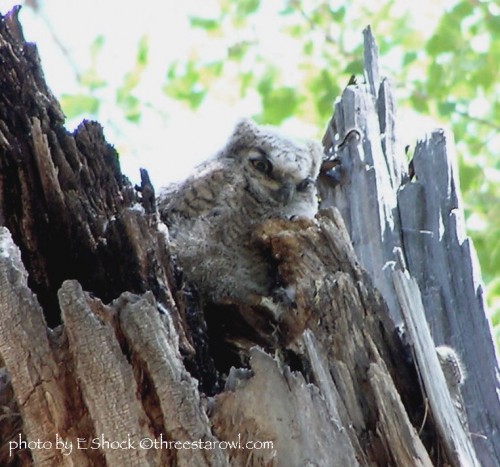 installed on the top of a phone pole while its parents search the alleys for rats or young cottontails to stuff into it. (If you enjoy camping, you’ve heard a sound like it: the creak made by the plastic hinge on a cooler lid when it’s raised.) The female makes the same sound during courtship while soliciting her mate for food. In our area, courting owls can be seen and heard duetting on phone poles and rooftops, visible against the fading sunset sky. As they call together or alternately — the male and female have slightly different voices and cadences — they bow and “hoo.” She holds her tail up, soliciting attention from the male, who strikes a courtly pose to “sing,” tail raised and wings down, maximizing himself like an operatic baritone (he’s smaller than her). Here’s an excellent quote, where the author’s voice slides from ornithologist to owl, almost inadvertently:
installed on the top of a phone pole while its parents search the alleys for rats or young cottontails to stuff into it. (If you enjoy camping, you’ve heard a sound like it: the creak made by the plastic hinge on a cooler lid when it’s raised.) The female makes the same sound during courtship while soliciting her mate for food. In our area, courting owls can be seen and heard duetting on phone poles and rooftops, visible against the fading sunset sky. As they call together or alternately — the male and female have slightly different voices and cadences — they bow and “hoo.” She holds her tail up, soliciting attention from the male, who strikes a courtly pose to “sing,” tail raised and wings down, maximizing himself like an operatic baritone (he’s smaller than her). Here’s an excellent quote, where the author’s voice slides from ornithologist to owl, almost inadvertently:
“Courtship is fairly boisterous and involves bowing, bobbing, posturing, vocalizing, and allopreening. These elaborate activities lead, as one might hope, to copulation.” (from Hans Peeters, Field Guide to Owls of California and the West, my current favorite owl sourcebook. In the same series as the excellent book on Horned lizards, the California Natural History Guides, published by the UC Press)
If it’s still light enough while all this is going on, you can see flashes of white feathers at their throats, the “gular patch”, flashing as each hoot puffs the owl’s throat briefly. It’s a semaphore for them, like the feather tufts on the top of the head: a way of producing meaningful signals to each other: facial expressions without flexible tissue like lips or eyebrows.
As big, powerful generalist predators, Great horned owls can make it almost anywhere. Their range is right across the US and Canada through Central America and into northern South America. They live in urban, rural, and wilderness areas: desert, woodlands, mountains, wetlands, grasslands and cities, so the chances are you have them where you live, too. Keep an eye open, an ear cocked, and the Chihuahua in at night.
Below are Horned owl salt and pepper shakers from Three Star Owl. Each pair is an adult with an owlet in different stages of development ($48/pair).
Couch’s spadefoots: Tons of tiny toadlets!
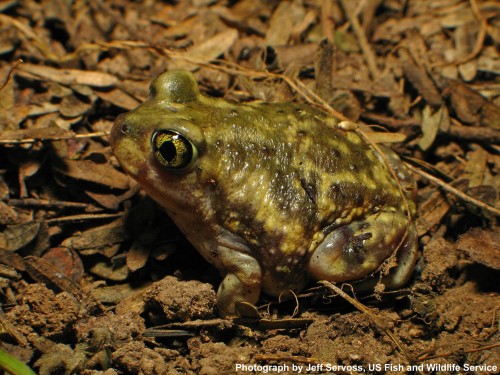 My friend Kathy gave me a bucket of toads. Twenty five tiny toads, actually Couch’s spadefoots (Scaphiopus couchii) to be precise. Spadefoots are toadlike amphibians, with their own family, Pelobatidae (see etymological note below). They’re native to the Sonoran desert, and their reproductive cycle is timed to take advantage of summer monsoon rains, needing only 7-8 days to go from egg to tadpole to toadlet. In between monsoon seasons, the adults stay buried deep in the soil of sandy washes to keep from drying out. They can stay buried for 8-10 months at a time, until storms bring the right conditions for them to feed and breed. The sheep-like bleating
My friend Kathy gave me a bucket of toads. Twenty five tiny toads, actually Couch’s spadefoots (Scaphiopus couchii) to be precise. Spadefoots are toadlike amphibians, with their own family, Pelobatidae (see etymological note below). They’re native to the Sonoran desert, and their reproductive cycle is timed to take advantage of summer monsoon rains, needing only 7-8 days to go from egg to tadpole to toadlet. In between monsoon seasons, the adults stay buried deep in the soil of sandy washes to keep from drying out. They can stay buried for 8-10 months at a time, until storms bring the right conditions for them to feed and breed. The sheep-like bleating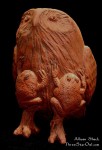 of the singing male spadefoot is an archetypal sound of the Sonoran desert. Some Arizona tribes associate toads and owls with monsoon rain, and that’s the origin of the fanciful Three Star Owl piece “Two-Toad Owl“.
of the singing male spadefoot is an archetypal sound of the Sonoran desert. Some Arizona tribes associate toads and owls with monsoon rain, and that’s the origin of the fanciful Three Star Owl piece “Two-Toad Owl“.
These little spadefoots hatched in a standing pool in Kathy’s Scottsdale yard, where they’re plentiful. They’re very tiny — each could sit on a penny. They’re so small that it wasn’t until I saw the close-up photos that their emerald green eyes were noticeable. If you’ve never nourished toadlets, they’re easy to feed: if it moves and fits in the toadlet’s mouth, they’ll eat it. These guys have been snarfing up crickets, and other protein-rich yummies like Miller moth larvae from birdseed (and an old bag of flour!). 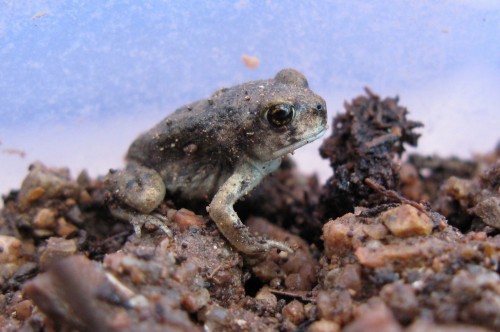 Even ants will go down the hatch, as long as it’s not one of the larger soldiers, which put off a noxious chemical. The one on the left was photographed before the first cricket feeding; it plumped up noticeably after downing a small cricket or two.
Even ants will go down the hatch, as long as it’s not one of the larger soldiers, which put off a noxious chemical. The one on the left was photographed before the first cricket feeding; it plumped up noticeably after downing a small cricket or two.
But I’m not keeping them in captivity. Once they’re fed up, I’ll release them in our yard at twilight, where hopefully they’ll replenish our neighborhood population. Releasing them after dark will give them a head-start over the foraging Curve-billed thrashers and Cactus Wrens. A couple years ago, we would hear male spadefoots bleating like lambs after a big rainstorm, and one or two would end up in the pool, looking for somewhere to breed. But recently, we haven’t heard or seen any. So I’m hoping these guys get things going again. Good luck, little spadefoots, and ‘ware Raccoons and Coachwhips!
Photos: the adult spadefoot photo is from the US Fish & Wildlife site on Arizona Amphibians. The other photos are by A. Shock. Excellent photos and still more info about Couch’s spadefoot can be found at Firefly Forest — check it out.
Etymolgical note and stray ornithological note
About the term “spadefoot”: It comes from the small, hard digging appendage on the underside of the back legs of these amphibians. Members of the family Pelobatidae are not considered “true” toads, so it’s proper to call them simply “spadefoots”. Pelobatidae, the family name for all Spadefoots, comes from a Greek word, pelobates (πηλοβατης), literally “mud-walker”. A nice tie-in for a potter is that the first element of this word comes from the Greek word pelos, meaning “clay”, specifically the clay used by potters and sculptors. 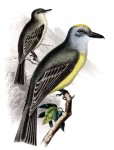 The genus, Scaphiopus, is constructed of two Greek elements and means “spade-foot”. The species name, couchii, comes from the surname of Darius Nash Couch, a U.S. Army officer who, during leave in 1853/54, traveled as a Smithsonian Institute naturalist to Mexico, where he collected specimens of both the Couch’s Spadefoot, and Couch’s Kingbird, a tyrant flycatcher native to south Texas and the gulf coast of Mexico. Out-of-range Couch’s kingbirds occasionally show up in Arizona. Recently, a Couch’s kingbird has wintered in Tacna in southwest Arizona, eating bees and behaving like a tyrant flycatcher.
The genus, Scaphiopus, is constructed of two Greek elements and means “spade-foot”. The species name, couchii, comes from the surname of Darius Nash Couch, a U.S. Army officer who, during leave in 1853/54, traveled as a Smithsonian Institute naturalist to Mexico, where he collected specimens of both the Couch’s Spadefoot, and Couch’s Kingbird, a tyrant flycatcher native to south Texas and the gulf coast of Mexico. Out-of-range Couch’s kingbirds occasionally show up in Arizona. Recently, a Couch’s kingbird has wintered in Tacna in southwest Arizona, eating bees and behaving like a tyrant flycatcher.
Spadefoot Update
All toadlets released tonight, in three batches around the yard, in areas with lots of cover, leaf litter, and access to sandy soil. Turns out there were about 30. They all hopped away dispersing almost instantly in the dark. They are hereby encouraged to eat earwigs and small cockroaches.
Isabelline California towhee in Huntington Beach Central Park
On Sunday, Aug 31 2008, while birding in the middle of the Civil War (or at least a re-enactment of it), I saw a sandy-beige bird feeding on the lawn at the edge of a brushy area in Huntington Beach Central Park. It was consorting with two typically-plumaged California towhees, and it appeared to be identical to them in everything but color. The entire bird was buffy, including flight and tail feathers, with no darker brown “towhee-colored” feathers on it, and was paler on the breast and underside. Its bill was pinkish-gray. I got good looks at the bird, with and without binoculars before it flew up into a small tree about 25 feet away, where it perched for a minute, making a sharp chip note that was towhee-like. Though it was partially concealed in the branches, it was possible to get a couple of digital images.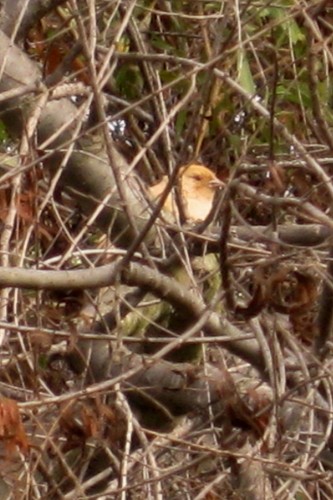 This is the best one, slightly cropped to make the bird larger in the frame. I believe it is an Isabelline California towhee.
This is the best one, slightly cropped to make the bird larger in the frame. I believe it is an Isabelline California towhee.
Perhaps this aberrant-plumaged individual is well-known to local birders (I’m from out-of-state); it certainly stood out against the green lawn, and was very much brighter in tone than the other typical, subdued California towhees it was with.
Other than an absurd number of Orange-crowned warblers and the previously mentioned Civil War encampment, it was the only notable sighting of the morning. The Audubon group (LA?) we met leaving as we came in were off to Bolsa Chica because nothing much was up in the Park, perhaps because of the cannon and rifle-fire?
As a born Californian, I will refrain from making any blond remarks and simply wish the bird success in evading accipiters, feral cats, and black-powder firearms.
Incidentally, here is an explantaion for the color term “Isabelline” meaning dun or dirty beige: “The name of Isabelline, this grayish-yellow colour comes from the colour of the underwear of Isabel Clara Eugenia, daughter of King Philip II of Spain who at the siege of Ostend vowed not to change her underwear until the city was captured. The siege lasted for three years so the colour of her underwear must have been truly grayish-yellow (isabelline) when the city was finally taken.” I cannot confirm accuracy, only cite internet source.
Accidental residents: reddish egrets and green sea turtles
I’ve just returned from a visit to the parental home in coastal Orange County California, where my mother still lives. The house is walking distance from the beach — all during the Labor Day weekend, we could smell the beach fires and hear the engines of small planes dragging ad banners low along the coast.
 When I was a kid, the beach was where we went to “lay out” or body surf. Now, I’m more likely to head to the Bolsa Chica Ecological Preserve, also within a short walk, to look at birds. One of the last remaining wetlands in southern California, Bolsa Chica has been a battle ground for decades between developers, politicians, environmentalists, and citizens.
When I was a kid, the beach was where we went to “lay out” or body surf. Now, I’m more likely to head to the Bolsa Chica Ecological Preserve, also within a short walk, to look at birds. One of the last remaining wetlands in southern California, Bolsa Chica has been a battle ground for decades between developers, politicians, environmentalists, and citizens.
Though its current state is more stable than it was, it’s hard to believe the struggle is over, since the Preserve is still being hemmed in by huge showy homes looking down onto it from the bluffs on one side and clanking, chugging oil rigs on the other. But in between is a haven well-known to birds and birders, as well as families and walkers with (forbidden) dogs. The Preserve is in a constant state of change, not only from natural phenomena like tides and the weather, but also man-made: fairly recently a channel was constructed to open the water of the Preserve to the sea — a re-engineering of its natural daily access to fresh ocean water, instead of a sluggish exchange of greasy harbor water that worked its way through local marina channels.  Observers are still evaluating the effects of this. But the terns and Black skimmers still nest on the sandy island, endangered snowy plovers have nesting areas safe from foot traffic and vehicles, and the endangered Belding’s race of the Savannah
Observers are still evaluating the effects of this. But the terns and Black skimmers still nest on the sandy island, endangered snowy plovers have nesting areas safe from foot traffic and vehicles, and the endangered Belding’s race of the Savannah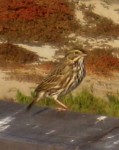 sparrow is sometimes ridiculously easy to see in the pickleweed. Small numbers of Least terns, also endangered, are harder to pick out from among the clouds of larger, skrekking Caspian, Elegant and Forster’s terns. Winter will bring ducks and grebes, and now in late summer, the shorebirds are returning, some, like a few of the dowitchers, still sporting shreds of buffy breeding plumage fresh from their arctic breeding grounds.
sparrow is sometimes ridiculously easy to see in the pickleweed. Small numbers of Least terns, also endangered, are harder to pick out from among the clouds of larger, skrekking Caspian, Elegant and Forster’s terns. Winter will bring ducks and grebes, and now in late summer, the shorebirds are returning, some, like a few of the dowitchers, still sporting shreds of buffy breeding plumage fresh from their arctic breeding grounds.
As havens often do, Bolsa Chica has attracted unexpected residents. For a couple of years now, birders have been watching a small number of Reddish egrets in the tidal flats — two that I know of — a species that is normally found in warmer regions. On the Bolsa Chica Conservancy‘s online bird list, the Reddish egrets rate only an “X” for “accidental”. They seem to know exactly what they’re doing, however, with their active 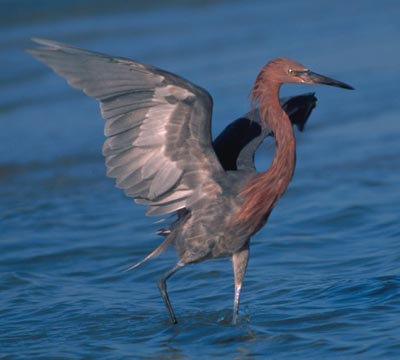 foraging dance in which they dart and hop, holding their wings above their head, snaking their long necks forward to snatch at small fish and invertebrates from the water at their feet. You’d expect to see these guys in Louisiana, or Mexico. But here they are doing what they do like they belong here, being spied upon by scopes and long lenses, among the resident Snowy and Great egrets and Great blue herons. Like immigrants everywhere, they are sometimes subject to competitive pecks and unwelcoming charges by the locals, in the form of irritable Great Blues whose personal space is compromised.
foraging dance in which they dart and hop, holding their wings above their head, snaking their long necks forward to snatch at small fish and invertebrates from the water at their feet. You’d expect to see these guys in Louisiana, or Mexico. But here they are doing what they do like they belong here, being spied upon by scopes and long lenses, among the resident Snowy and Great egrets and Great blue herons. Like immigrants everywhere, they are sometimes subject to competitive pecks and unwelcoming charges by the locals, in the form of irritable Great Blues whose personal space is compromised.
All of Southern California has a reputation for harboring incomers from other places. The Reddish egrets are only one example. Another, new to me as a non-resident, but apparently known to local fishermen and living here for a while, are Green Sea Turtles. A news story over the Labor Day weekend was the first I’ve heard of this: a Green sea turtle was rescued from where it was trapped in a dishcarge channel in the Haynes Generating Station on the grubby and channelized San Gabriel River. Check out the excellent LA Times article for the full fascinating story, but apparently there is a handful of these big turtles living at least part of their lives in the warm waters a short distance upstream  from where the San Gabriel empties into the Pacific at the border of LA and Orange Counties. Even more remarkable is that there is a large colony of these animals living in San Diego. This group numbers at least a hundred and, according to researchers, is headed up by a 570-pound matriarch they call “Wrinklebutt.” The theory is that the San Gabriel River turtle group is an outpost of Wrinklebutt’s colony. It makes them the northernmost known foraging population of Green Sea turtles in North America.
from where the San Gabriel empties into the Pacific at the border of LA and Orange Counties. Even more remarkable is that there is a large colony of these animals living in San Diego. This group numbers at least a hundred and, according to researchers, is headed up by a 570-pound matriarch they call “Wrinklebutt.” The theory is that the San Gabriel River turtle group is an outpost of Wrinklebutt’s colony. It makes them the northernmost known foraging population of Green Sea turtles in North America.
This coastal visit is well-timed for me artistically, bringing an influx of fresh ocean species, just at a time when I’m beginning work on pieces for the San Diego Bird Festival next March. So soon skimmers and terns and sea turtles will be migrating into Three Star Owl imagery, joining the desert species dwelling there already. And, maybe when I’m in San Diego, I’ll try to see Wrinklebutt and her cohorts.


